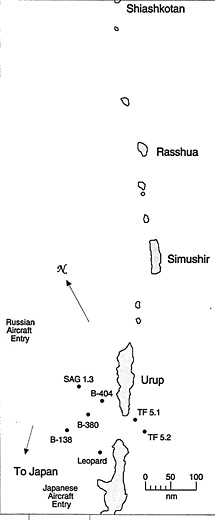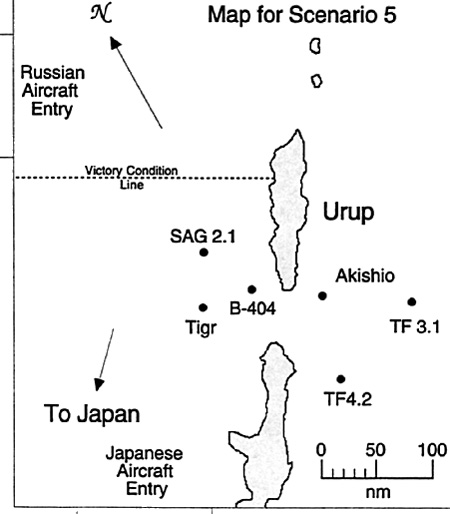Editor's note. This is the second part of a mini-campaign depicting a conflict between Russia and Japan (note I didn't say "Soviet Union. "I'm learning). The first part appeared in Issue 6.
Scenario 4: Surge
While the cease-fire has been in place for almost three days, both sides have no illusions that the conflict is over. The Japanese Army has secured 80% of Urup Island and is shipping in supplies and reinforcements to continue the war if necessary. For the Russian forces it is a different story, as their garrison is still holding out, even though virtually surrounded. Although losses on both sides have been extremely heavy, it is worth the price for the economic benefits the oil and minerals will bring to the victor. The Russian commanders have decided to break the cease-fire and renew hostilities by surging as many submarines as possible through the spread-out Japanese Navy. They will then be in a position to cut off all Japanese reinforcements to Urup and retake the island.
Setup: The Russian Surface Action Group sets up anywhere in the designated area on the map with all submarines deployed anywhere within 10 nm of the setup area. The Russian Strike Force enters on the designated map edge D6 + 20 minutes after being called for. Both Japanese Task Groups set up in the designated areas and the CAP flight is orbiting over Urup Island at medium altitude. The Strike Group enters at the designated entry point D6 + 15 minutes after being called for.
Environment: 1600 local time, overcast, 70% visibility, sonar performance is 80% with CZs at 30 nm, 60 nm, and 90 nm. Sea state 3 with the wind from 130' at 15 knots
Russian Orders: Our forces on Urup, backed by massive airstrikes will counterattack out of their positions tomorrow. To ensure that Japanese reinforcements will not interfere, we will move several submarines into a holding position on the far side of Urup Island. Use the surface action group and air units to tie up the Japanese naval units while the submarines deploy into the shipping lanes.
Russian Forces: Surface Action Group 1-3: Bespokoynyy (Sovremennyy class DDG), Admiral Pantekyev (Waloy class DD), and R'yanyy (Krivak II class FF).
Sub Group 1: Leopard (Bars [Akula class SSN)
Sub Group 2: B-138 (Victor III class SSN)
Sub Group 3: B-404 (Kilo class SS)
Sub Group 4: B-871 (Kilo class SS)
Strike Group:
4 MiG-29 (each with 2 AA-10C and 4 AA-11)
4 Su-24 (each with 2 AS-14, 2 AS9, and 2 AA-11)
2 Su-24 (each with 2 AS-14 and 4 KAB-500L)
2 MiG-27 (each with 2 AS- 10 and 4 PKT-250 CBU)
Japanese Orders:
With renewed hostilities imminent, we have decided to put additional reinforcements at sea so that once the cease-fire breaks down they will be able to immediately land. The Russian surface forces have taken serious losses in the war but still maintain a large submarine force in this theater. Our forces are spread thin and must guard against letting these submarines operate in our shipping lanes.
Japanese Forces: Task Force 5. 1: Shirane (Shirane class DDH) with 3 SH-60j, Asakaze (Tachikaze class DDG), and Setoyuki (Hatsuyuki class DD).
Task Force 5.2: Hatakaze (Hatakaze class DDG), with I SH-60J, Shirayuki and Yamayuki (Hausquki class DDs).
CAP Flight: 2 F-15J (each with 4 AIM-120 and 4 AIM-9M)
Strike Group:
2 F-4EJ (each with 4 AIM-9M, 2 GBU-10, 6 Mk 82,3 AIM-7F and 1 ALQ-119)
2 F-4EJ (each with 4 AIM-9M, 12 Mk 82, and 3 AIM-7F, and 1 ALQ- 119)
Special Rules: 1. Because of the numerous early warning and detection assets in the area there is a good chance that both sides will know the location of enemy aircraft and ships. If the scenario is played without a referee, then all air and surface groups are automatically detected. If there is a referee, he should provide information to both players as follows. After both sides have set up, one D10 is rolled for each surface or air group on the map (or that subsequently enters the map). If the roll is 1, then the group was not sighted; if the roll is 2 or 3, then the location of the group is known within 20 nm; if the roll is 4-7, then the location of the group is known within 10 nm; if the roll is 8 or 9, then the exact location of the group is known; if the roll is a 0, then the exact location, formation and heading is known. There is a + 1 modifier to the die roll if the group is using active sensors.
2. All aircraft have been refueled by tankers before entering the map area and are assumed to have full tanks. submarines are deployed according to their marked positions on the map. The Japanese CAP is orbiting the center of Urup at medium altitude while the P-3's are deployed anywhere within 20 nm of any Japanese surface unit. The Japanese Strike Group enters from the designated map edge at D6 + 20 minutes after being called for.
Environment: 0800 local time, overcast, 80% visibility, sonar performance is 90% with CZs at 30 nm and 60 nm. Sea state 3 with wind from 1200 at 10 knots.
Russian Orders: Our forces are pulling back from this area to regroup and strike elsewhere in this theater of operations. To ensure that Japanese forces do not interfere with the withdrawal all of our available surface forces in the area will conduct a delaying action. There is a strong Japanese Task Force moving to cut off the withdrawal by flanking us to the west of the island. Intercept and inflict as much damage as possible to the enemy task force.
Russian Forces:
Surface Action Group 2. 1: Varyag (Ex-Chervona Ukraina (Slava-class CG), Vazhnyy (Sovremenn)y class DDG), Marshal Shaposhnikov (Waloy class DD), Kedrov (Krivak III class FF)
Sub Group 1: Tigr (Bars [Akula] class SSN)
Sub Group 2: B-404 (Kilo class SS)
Strike Group 1:
4 Su-27 (each with 4 AA-10C and 4 AA-11),
4 Su-24 (each with 2 AS-14 and 2 AS-9)
Strike Group 2:
2 MiG-29 (each with 2 AA-10C and 4 AA-11),
2 MIG-25BM Foxbat F (each with 4 AS-11)
6 MiG-23 (each With 2 AS-10 and 2 FAB-250M62).
Japanese Orders: U.S. satellite intelligence shows that Russian forces are attempting to withdraw from Urup Island and large numbers of transports have been reported near the northern end of the island. Our forces will launch a diversionary attack on the eastern side of Urup to tie down their submarine forces while a strong surface Task Force moves around the western side to intercept the withdrawal. If enough ships can make it past the last few remaining defenders our forces can achieve an overwhelming victory to end the war.
Japanese Forces:
Task Force 4.2: Kurama (Shirane class DDH), Kikuzuki (Tachikaze class DD), Sawakaze Tachikaze class DDG), and Isoyuki Hatsuyuki class DD)
Task Force 3. 1: Asagiri (Asagiri class DDG), Hatakaze (Hatakaze class DDG), Ukuzuki (Takatsuki class DD).
Sub Group 1: Akishio (Yuushio class SS)
CAP: 4 F- 15J (each with 4 AIM-120 and 4 AIM-9M)
ASW Patrol: I P-3C (with 8 Mk46 and 2 Harpoon)
Strike Group 1: 2 F-15J (each with 4 AIM-120 and 4 AIM-9M)
4 F-15J (with 4 AIM-9M, 2 GBU12, and 6 Mk82)
4 F-4EJ (each with 4 AIM-9M, 12 Mk82, 3 AIM-7F, and 1 ALQ-119).
Special Rules:
1. Use Rule 1 from Scenario 4.
2. Use Rule 2 from Scenario 4.
3. All ships that carry helicopters as part of their normal complement (or loadout) are assumed to have them and they may be armed as both sides see fit.
Victory Conditions: After 1800 hours the Japanese player counts how many Japanese ships are north of the designated line on the map and consult the victory conditions below to determine the level of victory. Akishio counts as two ships for purposes of victory determination.
-
0-2 Ships: Russian Tactical Victory - Russian forces have delayed the Japanese long enough to remove almost all of their forces intact. There is some damage inflicted by marauding enemy forces, but not enough to slow the withdrawal.
3-5 Ships: Draw - Japanese forces destroy several transports and cause severe losses in both men and equipment. Both sides are severely bloodied, leaving the Japanese unable to follow up and finish the Russians off. The Russians are also unable to continue offensive operations because of their severe losses and will have to wait several years before renewing the struggle.
6-9 Ships: Japanese Tactical Victory - Japanese forces strangle the withdrawal, causing the loss of 90% of the transports and several thousand casualties. The battle for Urup Island is over, leaving the Japanese victorious and leader of the Pacific Rim for years to come.

Map for Scenario 5

BT
Back to The Naval Sitrep #7 Table of Contents
Back to The Naval Sitrep List of Issues
Back to MagWeb Master List of Magazines
© Copyright 1996 by Clash of Arms.
This article appears in MagWeb (Magazine Web) on the Internet World Wide Web.
Other military history articles and gaming articles are available at http://www.magweb.com